It is often asked: what is the optimal chain length for a bicycle with derailleurs? Should a new chain be shortened and how much? That is answered in this post. For single speed bicycles (or bikes with internal gear hubs), see: Determining optimal single speed chain length.
Table Of Contents (T.O.C.):
- Bicycle drive chain length
- The importance of determining the correct chain length
- Chain length sizing for bicycles with derailleurs
- Rear derailleur chain wrap capacity not big enough
- Shortening and re-connecting bike chains
TL/DR
Here, I explain:
- Why it’s important to cut your chain to the optimal length?
- How to measure that (before cutting 🙂 ) for 1-X vs double and triple crank drivetrains?
- What can you do if your chain is too long for your RD cage to handle?
1. Bicycle drive chain length
A new bicycle chain usually comes with 116 links. This is long enough for the biggest chainrings and for most distances of rear wheel from front chainrings. So for optimal length a new chain is usually shortened from the 116 links that come in the box. In rare occasions – touring frames for example, with extremely long chainstays, 116 links might not be long enough, so a few links off another new chain need to be added to reach optimal chain length.
2. The importance of determining the correct chain length
Too long chain will increase risk of chain dropping, while too short chain puts too much stress on the drivetrain, or can damage it, if it can be put and closed over the chainrings in the first place. Chain that is too short can also damage rear derailleur.
3. Chain length sizing for bicycles with derailleurs
There are several methods for getting the chain at the correct length. The method explained here is certain to result in a chain long enough not to cause any drivetrain damage. The method is called “big-big”.
In order to make absolutely sure the chain is long enough, it should be put around the biggest chainring in the front, the biggest sprocket at the rear and then add one more inch, i.e. one link because of the derailleur (one link consists of a pair of outer and inner plates, as shown in the picture below – it is often referred to as “two links”). When measuring, the chain is not put through the rear derailleur, the derailleur is moved so it doesn’t get in the way.
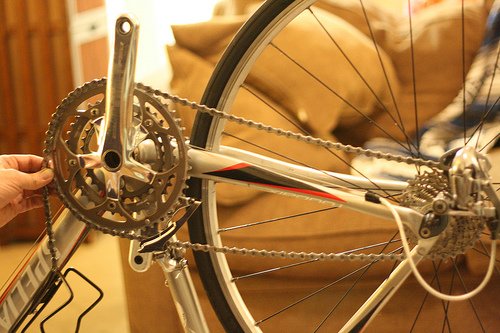
This makes the chain one inch longer to accommodate the rear derailleur.
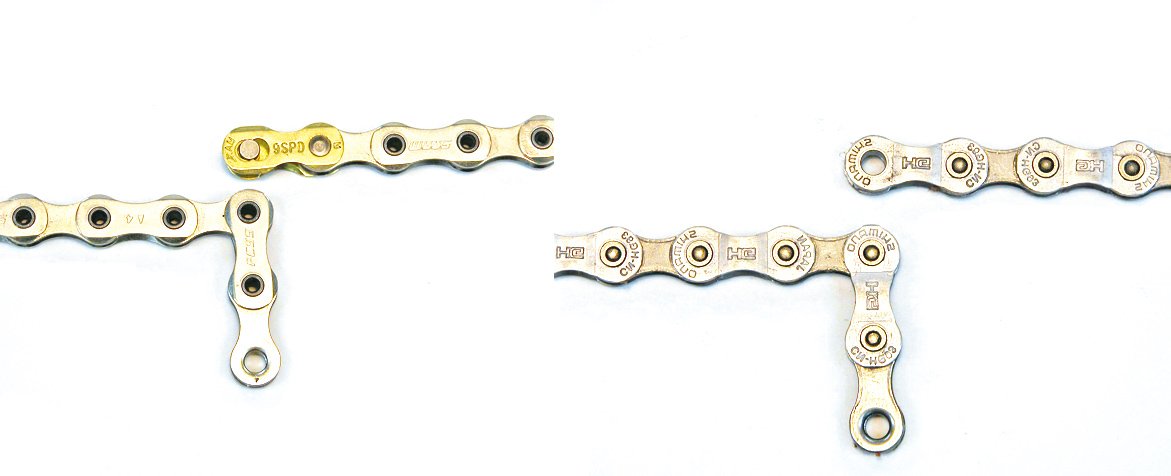
On the left is a chain with a quick link, while on the right is a “standard” chain using a connecting pin.
For bicycles with rear suspension, the suspension should be totally bottomed – compressed when using this method. See the position of travel where the rear wheel is furthest away from the cranks. To achieve this with air shocks just let the air out, while for ones with spring one has to remove the shock, remove the spring, then put the shock back. Simpler, though not 100% reliable method is adding one extra pair of inner and outer links to the length determined by the method explained below.
With modern, more and more popular systems that have one chainring in the front and multiple chainrings in the back (“1x” systems), the optimal length is achieved when adding two extra links, instead of just one, after wrapping the chain around the only front chainring and the largest rear sprocket.
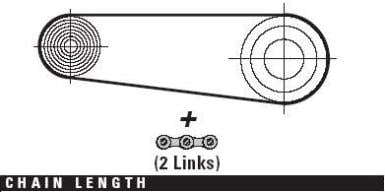
For bicycles that have more than one front chainring, i.e. those with a front derailleur.
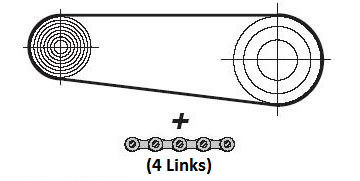
For bicycles with only one front chainring, i.e. without a front derailleur.
(see pros and cons of 1x drivetrains)
That’s all. A simple method. What to look out for?
Help BikeGremlin
stay online & independent
This website is educational, free, objective, and not commercial
(sponsors don’t enjoy paying if you mention all the product downsides that you notice 🙂 ).
How much does a WordPress website cost?
If you find this site to be good and helpful,
and if $5 per month is what you can afford to set aside,
please consider supporting my work with a Patreon donation:
4. Rear derailleur chain wrap capacity not big enough
Rear derailleur chain wrap capacity may not be big enough.
The explanation of what RD capacity is can be found under “Derailleur capacity” in this page: Rear derailleur.
This results in a situation that in a small-small chainring combination, the chain is too slack and can even fall off chainrings on bumpy roads.


Bottom part of the chain is rubbing the top RD jockey wheel.
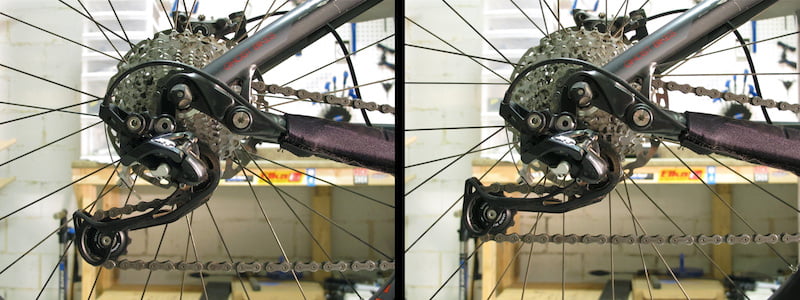
Chain to the right is still a bit too long for the RD wrap capacity, just not as extreme as in the two pictures above.
RD cage is parallel to the ground, making it hard for the RD to tighten the chain strongly enough.
This problem can be solved in three ways:
- Getting a rear derailleur with a longer cage.
- Avoiding smallest few sprockets at the cassette when the chain is on the smallest chainring in the front.
- Shortening the chain.
The third method is potentially dangerous, because in a big-big combination the chain will no longer be long enough. This can result in tearing the rear derailleur when changing to the biggest sprocket at the rear if the big chainring is used in the front.
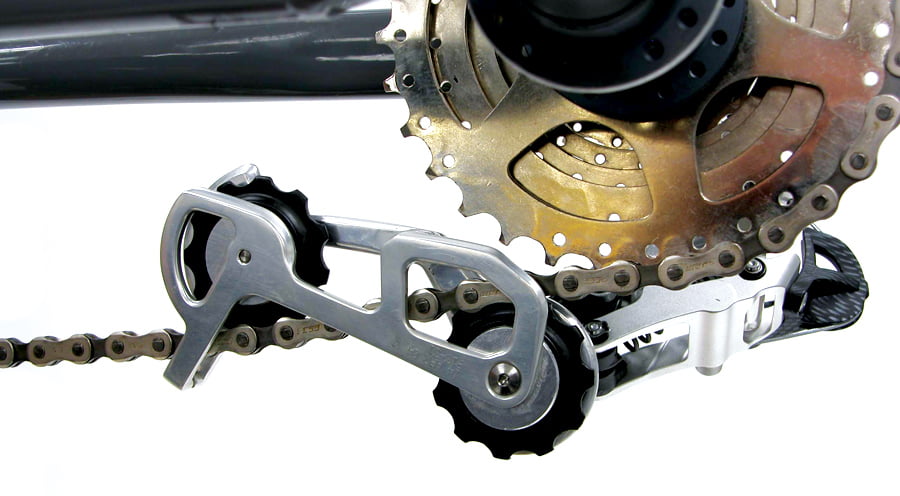
It managed to shift into big-big combo, but there is almost no bend at the derailleur jockey wheels.
Small-small and big-big combinations are combinations to avoid anyway, because the chain is cross-chained in those combos, the same gear ratio can be achieved with a middle-middle combination easily. Still, it can happen that in a moment of lesser caution, one does shift into one of those combinations. That is why, if method 1 is not possible for any reason (financial or some other), it is safer to use method 2 than method 3.
5. Shortening and re-connecting bike chains
For this, I’ve made a video demonstration:
Related post – How to lubricate a bicycle chain:

The existing comments posted under this article (questions and answers) have been moved to this BikeGremlin forum thread:
https://www.bikegremlin.net/threads/chain-length-sizing-for-bicycles-with-derailleurs-article-comments.124/


Are chain typically bought new for a bicycle the right size or need to be a shortened?
Hi Michael,
Bicycle chains usually need to be shortened (cut to size).
Relja
Great article (like many in this “wiki”).
By how many links can you get the chain length “wrong” without running into trouble?
Some context: I’m considering sliding dropouts to adjust chainstay length on a self made custom frame. How much sliding dropout range is possible without having to change the chain when going from one end of the dropout range to the other?
Hi Nic,
The minimum length is determined as explained in this article.
In your case – that would be tested with the wheel furthest out from the cranks (as far as you intend to move it).
Maximum lenght generally needn’t exceed the determined minimum length – no use having those extra links.
Nonetheless, you RD chain wrap capacity is the real limiting factor here – the point when using the small-small chainring combo (front-rear) causes the chain to go as shown in the second picture in the 4th chapter in this article.
This is less problematic than using a chain that is too short – it won’t damage the RD (unless you ride for miles like that).
Hi Relja,
that makes sense if I already had the bike and could test it but I still have to build it and pick a range (10mm, 15mm, 20mm etc) for the sliding dropout. Is it possible to say how many links one can be away from the optimal length without having issues (given a MTB long cage derailleur)?
Hi Nic,
The answer depends on the drivetrain.
If you have a wide range cassette (11-40 or similar) + a wide range triple cranks, there will be less “room” for the RD to pick up any chain slack even with the optimal chain length.
In that case, perhaps one extra pair of links (1″) is as far as it will go.
With double cranks, and a more “conservative” cassette (say 11-32, or even 11-34), the long cage RD should be able to handle 2 or more extra pairs of links (2″, 4 pins/rivets).
Generally, with a long cage RD, I would expect 20 mm movement to be manageable.
But, to be certain, check the stated RD chain-wrap capacity, and see your total drivetrain tooth count difference (lareste rear minus smallest rear + largest front minus smallest front).
If you have room for 4 more teeth in terms of RD chain wrap capacity, 20 mm should be manageable.
That was an exhaustive answer, thanks a lot. I should have given you my complete specs which are: 11 speed system, 2x GRX front derailleur (30-46), 11-42 MTB cassette, Shimano XT SGS RD, and the chainstay range I’m aiming for is around 440mm if that matters. So that would make a 1 (or even 2?) chain link deviation in either direction from the mid point of the sliding dropout range possible?
Side note: I have a flat bar so I will use a flat bar road FD shifter and a MTB RD shifter. Just in case you were wondering how I will shift this Frankenstein construct.
Hi Nic,
I’d start by googling the exact RD model’s stated chain-wrap capacity.
For example, Shimano XT RD-M8130-SGS has a 39 teeth total capacity.
Shimano Deore RD-M5120-SGS has 41T.
Alivio RD-M3100-SGS has 45T.
And so on and so forth.
Your current drivetrain has a total of 47 tooth difference.
That’s huge.
Based on that, I think you will have to make a compromise:
– Either go with a chain that is a bit too short and avoid shifting to the big-big combo (to avoid damaging the RD).
– Or go with a chain that is of an optimal length for your longest (farthest) setup, and avoid using the small-small combo to avoid chain slapping too much and sliding over the jockey wheels as noted in one of my previous replies.
Alternately, you could use a 12-34 T cassette, or an 11-32 or similar, to reduce the total tooth-count difference and give yourself some room.
I suppose that moving the rear wheel by 20 mm equals roughly 1″ (1 pair of links) chain length difference, and about 4T capacity difference (in terms of RD chain wrap).
Guessing, didn’t sit down to calculate diameter differences and similar.
I was going to use an Shimano XT RD-M8000 11 speed SGS RD. Acc to https://bike.shimano.com/en-EU/product/component/deorext-m8000/RD-M8000-SGS.html it has a 47 tooth capacity. That does sound a lot in the context of the other RD you mentioned. Does that then still require the compromise you suggested? I guess not because the capacity matches.
The formula I used to calculate chain length is (in chain links) 0,157 * “chainstay length” + 1/2 “biggest front ring” + 1/2 * “biggest rear ring” + 2. The result with 445mm chainstays is 116.8 links. I got the formula from https://www.kurbelix.de/blog/anleitungen/ketten/die-richtige-laenge-der-fahrradkette-berechnen-ermitteln#:~:text=Um%20die%20richtige%20L%C3%A4nge%20der,dieses%20Ergebnis%20dann%20durch%202. This one https://www.omnicalculator.com/sports/chain-length spits out 116 for the same specifications. If I reduce chainstays length in the above formula to 430 then it’s 114.5 links. The Omni calculator website says 114 links. So the formula seems to work. Then the delta in ideal chain length for a 15mm sliding dropout is a total of 2.3 links and a 1.15 link difference when going from the ideal mid point at 437.5mm chainstay length to either end of the range. I just don’t have a clue whether 1.15 link deviation from the perfect chain length is bad enough to chause problems or might I even be able to afford a 20mm sliding dropout, or a 30mm…the more the marrier:)
Hi Nic,
Your drivetrain has 47 teeth difference in tooth count. So that RD should be able to take up all the slack if the wheel is not moved back/forth.
The optimal chain length is basically the shortest length that allows you to shift into the big-big combo without breaking anything.
If you intend to move the wheel back-forth, you should measure that in the furthest rearwards wheel position.
Then, when you move the wheel forward, the RD will have more “extra” chain length to keep wrapped (the optimal chain length is effectivelly reduced).
Moving the wheel forward by 20 mm resulty in about 3 more teeh of the needed RD capacity increase (if my math is remotely correct).
Since XT RD-M8000 chain wrap capacity is right at the limit with your drivetrain, it may not be able to pick up all the chain slack when you shift into small-small combo.
And it may not do too well for the smallest 2-3 rear chainrings when you are on the small front chainring.
In such situations, some riders prefer to cut the chain a bit shorter and avoid shifting into big-big combo.
That way, the chain will not slap as much, will be held tighter, but if you shift into big-big by mistake, you risk damaging at least the RD (possibly hanger as well).
Others prefer leaving the chain with the “safe” length, and put up with a bit more chain bounce on bumpy roads, and more noise if they shift into small-small combo.
Having said all this, the safest method is to just test.
Measure the needed chain length for the big-big combo (as explained in this article) when the wheel is furtherst to the rear.
Then install it through the derailleurs and over the chaingins, move the wheel forward, shift into the small-small combo and see if it’s all good, or too long for the RD to handle.
It might just be OK. And it might not. If it’s too long – it’s your call how you want to deal with it (shortening the chain vs leaving it with the “safe” length – as explained above).